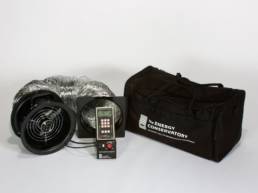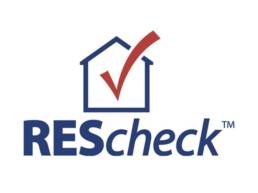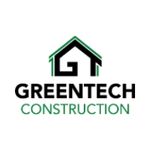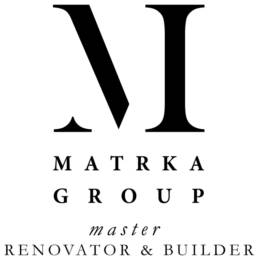Welcome to Energy Matters
We provide energy-efficient products and services for homeowners, contractors, and builders in Columbus, Ohio, and the surrounding area.
Blower Door Test
Currently In Delaware, and most surrounding counties, an air infiltration test is necessary to obtain an occupancy permit. Paper Certificate is left on site, emailed to the builder, and label printed and adhered to the breaker panel for code official to check. House should be in the finished stage, with all doors and windows installed, trim, floor covering, outlet covers, and attic hatch in place. Most homes are built to the current standard with Tyvek house wrap test at about 3 to 3.5 ACH50.
Code Reference
Tested air leakage is less than 5 ACH when tested with a blower door at a pressure of 50 pascals (0.007 psi). Testing shall occur after rough-in and after installation of penetrations of the building envelope, including penetrations for utilities, plumbing, electrical, ventilation, and combustion appliances.
Duct Leakage
Code requires ducts to be tested when they are located in unconditioned space, such as an attic. Code requires leakage to be less than 4% as compared to the sq ft area served. The test can be conducted anytime during construction but in order for the test to qualify, air handler must be installed.
Code Reference
Ducts shall be pressure tested to determine air leakage by one of the following methods:
- Rough-in test: Total leakage shall be measured with a pressure differential of 0.1 inch w.g. (25 Pa) across the system, including the manufacturer’s air handler enclosure if installed at the time of the test. Registers shall be taped or otherwise sealed during the test.
- Post-construction test: Total leakage shall be measured with a pressure differential of 0.1 inch w.g. (25 Pa) across the entire system, including the manufacturer’s air handler enclosure. Registers shall be taped or otherwise sealed during the test.
Exceptions:
- A duct air-leakage test shall not be required where the ducts and air handlers are located entirely inside conditioned space.
- A duct air-leakage test shall not be required for ducts serving heat or energy recovery ventilators that are not integrated with ducts serving heating or cooling systems.
A written report of the results of the test shall be signed by the party conducting the test and provided to the building official.
The total leakage of the ducts, where measured in accordance with Section 1103.3.3, shall be as follows:
- Rough-in test: The total leakage shall be less than or equal to 4 cubic feet per minute (113.3 L/min) per 100 square feet (9.29 m2) of conditioned floor area where the air handler is installed at the time of the test. Where the air handler is not installed at the time of the test, the total leakage shall be less than or equal to 3 cubic feet per minute (85 L/min) per 100 square feet (9.29 m2) of conditioned floor area.
- Postconstruction test: Total leakage shall be less than or equal to 4 cubic feet per minute (113.3 L/min) per 100 square feet (9.29 m2) of conditioned floor area.
Columbia Gas Utility Incentive Program
Details
EfficiencyCrafted™ homes have been built to higher standards, and are required to pass a rigorous inspection. Each efficiency element built into the home is designed to increase your comfort, reduce your energy bills, and maintain your home’s value. Build your home for a good value for today, and a better investment for tomorrow. With an EfficiencyCrafted™ home, you’ll get:
Lower Energy Bills
EfficiencyCrafted™ homes can use up to 30% less than traditional homes. And, the ENERGY STAR® certified appliances featured in EfficiencyCrafted™ homes use up to 50% less energy than standard models. According to EPA estimates, this can save families an average of $400 per year on their bills.
High-Quality Construction
An EfficiencyCrafted™ home is built to nationally recognized standards for energy-efficient construction. Participating builders incorporate high-performance equipment and building practices, together with independent testing and verification to ensure that quality and savings endure for decades to come.
Peace of Mind
All EfficiencyCrafted™ homes undergo rigorous testing from a qualified, independent energy rater certified under the Home Energy Rating System® to help assure you’re getting maximum energy efficiency, savings and value. And, your HERS rated home can improve your resale value, should you decide to sell.
Improved Comfort
All EfficiencyCrafted™ homes are built to minimize leaks and drafts that cause hot and cold spots. Their innovative use of insulation, advanced sealing techniques, and high-efficiency heating and cooling systems all work together to provide year-round, wall-to-wall comfort.
A Healthier Environment
An EfficiencyCrafted™ home can be a healthier place to live. All homes feature ventilation systems that help improve air quality, reduce humidity, and remove odors. Less moisture, particulates, and allergens in the air mean you can
The Residential Energy Services Network (RESNET) was founded in 1995 as an independent, non-profit organization committed to helping homeowners reduce the cost of their utility bills by making their homes more energy-efficient.
RESNET is responsible for creating the national training and certification standards for HERS Raters and Home Energy Survey Professionals, both of which are recognized by federal government agencies such as the U.S. Department of Energy, the U.S. Environmental Protection Agency, and the U.S. mortgage industry.
In order to qualify for RESNET certification, home energy professionals must first complete the rigorous training required to meet the high standards of excellence demanded by RESNET and agree to abide by the RESNET Code of Conduct.
In short, it is a method to calculate the energy efficiency of the house using a metered system. Lower numbers are better. HERS is short for “Home Energy Rating System®.” Here’s how it works. The lower the score, the more energy efficient the home. Typical existing older homes have a score over 100, while standard built new homes have scores in the range of 70 -100. EfficiencyCrafted® homes score below 70 and often as low as 55–signifying the home is 45% more efficient than a 100-point reference home. Builders that participate in the EfficiencyCrafted program are required to use a combination of proven technologies, advanced building practices and performance testing to drive down the HERS scores of their finished homes.
Second aspect of being a rater is helping the builder, build a better, more efficient house. There is no reason why scores cannot improve in time as builder and contractors gain knowledge about what makes a house more efficient, more safe, and more durable. The point is to share knowledge and expertise in order to enable the builder to build a better more efficient structure.
REScheck reports and air infiltration tests are also available for code compliance. Please call for details.
WHY PARTNER WITH EPA? THAT’S EASY. THROUGH ENERGY STAR, EPA HELPS YOU CONNECT THE DOTS BETWEEN PEOPLE, PLANET, AND PROFITS.
Did you know the average building wastes about a third of the energy it uses? That’s why good energy management is good business. By capturing these inefficiencies, you can reduce your energy costs. And by reducing the amount of energy you use, you prevent greenhouse gases from being emitted at power plants, which helps create a cleaner, healthier environment.
It’s a budget-tested and planet-approved strategy for achieving the triple bottom line.
Here are just a few of the ways EPA can help you save.
Learn From The Experts
By following EPA’s proven energy management approach, you’re following in the footsteps of thousands of successful partners that have already tested and found the most effective, strategic approach to saving energy and money. Through theENERGY STAR Guidelines for Energy Management, EPA gives you a road map to setting up an energy program that will continue to deliver savings, year after year.
Use Actionable Benchmarks
Through ENERGY STAR Portfolio Manager, EPA’s online tool for measuring and tracking energy and water use, you have access to more than 150 different metrics that give you insights into how your property is performing. Certain property types also receive a 1 – 100 ENERGY STAR score, which compares a property’s energy performance to similar properties nationwide. Use it to speak effectively to key decision-makers and provide quantitative results to encourage better energy management and capital investment in energy-efficient technologies.
Get World-Class Support
Technical information, management tools, training sessions, networking meetings, marketing materials, off-the-shelf employee outreach kits … EPA offers you these resources and more to make your job easier. We also help you find expert help through our network of service and product providers.
Align With A Trusted Brand
When you align with ENERGY STAR, you increase your brand’s credibility and visibility. That’s because ENERGY STAR is a trusted government-backed source of unbiased information. It’s also recognized by more than 85 percent of the American public and tied with the Good Housekeeping® seal as the most influential consumer emblem in the nation.
Get Green Building Certification
A building can’t be green unless it’s energy-efficient. And ENERGY STAR is the government-backed program for certifying energy-efficient buildings. That’s why green building rating systems across the nation include ENERGY STAR. Whether you’re pursuing Leadership in Energy and Environmental Design (LEED), Green Globes, or the U.S. Guiding Principles for High Performance and Sustainable Buildings, ENERGY STAR certification will ensure your building uses less energy and leaves a smaller carbon footprint.
Highlight Your Proven Results
When you save energy, the financial value isn’t just limited to your utility bills. It accrues across the board — from asset values to shareholder values to operating income. And beyond the positive financial impacts, saving energy also makes a real-world impact in reducing greenhouse gas emissions.
So how can you convey all these proven results in a simple, objective way? ENERGY STAR is the symbol of financial performance plus environmental performance. Through ENERGY STAR, EPA makes it easy for you to differentiate your organization’s achievements with objective, government-backed benchmarks. Use it to make your financial and sustainability leadership stand out from the rest.
Are you ready for a home that lives, works, and lasts better? The home of the future – a better home – is available today. Take a virtual tour of homes that are so energy efficient a renewable energy system can offset all or most of their annual energy consumption. These award-winning homes are independently certified to meet DOE Zero Energy Ready Home guidelines and constructed by a select group of top builders. Zero Energy Ready Home is part of the U.S. Department of Energy’s Better Buildings initiative. Better Buildings aims to make commercial, industrial, public, and residential buildings 20 percent more energy-efficient over the next decade.
The DOE Zero Energy Ready Home is a new and compelling way to recognize builders for their leadership in increasing energy efficiency, improving indoor air quality, and making homes zero energy ready.
The program builds upon the comprehensive building science requirements of ENERGY STAR® for Homes Version 3, along with proven Building America innovations and best practices. Other special attribute programs are incorporated to help builders reach unparalleled levels of performance with homes designed to last hundreds of years.
DOE Zero Energy Ready Homes are verified by a qualified third party and are at least 40%-50% more energy-efficient than a typical new home. This generally corresponds to a Home Energy Rating System (HERS) Index Score in the low- to mid-50s, depending on the size of the home and region in which it is built.
THIS IS THE ACADEMIC PORTION OF OUR BUSINESS; IT IS ALSO A LAW OF PHYSICS THAT WE CANNOT ESCAPE, WE CAN ONLY LEARN TO WORK WITH IT AND REDUCE IT AS MUCH AS POSSIBLE.
Basically stack affect works like this…
As air is heated, the heated air increases in pressure, becomes lighter, and drifts toward the top of the house. Pressure systems are always trying to equalize as high pressures ALWAYS travels to cold air which is low pressure. So in winter conditions, the air you are heating will seek after and be drawn out by the cold air outside your house and in the attic. This air is then replaced at the bottom of the house by cold air (low pressure) because cold air outside is sucked into the basement through any hole it can find. Air moves into the basement because the basement being slightly below ground creates lower pressure than outside air. As air gets heated it moves up through the house and the process is repeated over and over again.
So the goal of making a house efficient is to recognize this process, and take steps to reduce it. This is why the blower door and thermal camera are so essential in the process. The blower door test, not only gives us the important rate we are looking for, but tells us where air is entering the house so it can be stopped. Once stack affect is stopped to an acceptable rate the house can heat and cool more efficiently.
Not a common term, I will give you that. Building science came out of the need to look at the home as a system. Have you ever heard stories of HVAC contractors removing insulation from wall cavities or attic floor to put in their equipment and not returning to place. What about the classic story of the plumber cutting floor joists to install a waste line, or copper supply lines running through a soffit which then froze this winter due to the area being insulated but not air sealed. All of these are remedied when you look at the house as a system.
REScheck
The REScheck product group makes it fast and easy for builders, designers, and contractors to determine whether new homes, additions, and alterations meet the requirements of the IECC or a number of state energy codes.
REScheck also simplifies compliance determinations for building officials, plan checkers, and inspectors by allowing them to quickly determine if a low-rise residence meets the code.
Company Review
“ We have had the privilege of working with Energy Matters LLC for over 5 years. Dwayne goes above and beyond to explain efficiency rating results as well methods to improve. Dwayne is professional and goes above and beyond to deliver his service on time! ”
⸺ The Arcaro & LaRussa Co.
How we can help?
Use the form to request information and availability. If you need immediate help, please give us a call at 614-489-9580.










